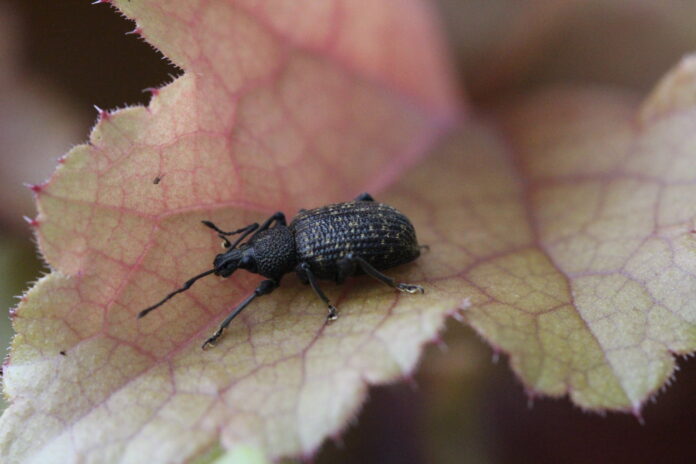Eugenia Fezza,Teagasc Walsh Scholar, discusses methods for improving the monitoring and control of black vine weevil in crops
VINE WEEVIL: A PERSISTENT HORTICULTURAL PEST
The black vine weevil (Otiorhynchus sulcatus) is a common and widespread species in Ireland and the UK that affects over 150 plant species, including soft fruits and ornamental crops. While a common pest, it is still regarded as one of the most damaging insect pests in protected horticulture. Due to the nocturnal activity of adults and the larval stages feeding below ground on plant roots, growers often report difficulty in detecting the presence of this pest and it is often only confirmed after severe damage has occurred.
Adult vine weevils are 8.5–11.5mm in length and dull grey/black in colour, but with tufts of orange hair on their fused wing cases. All vine weevils are female and each individual is capable of laying several hundred eggs between spring and late summer. This means that new populations of this species can establish from a single weevil. The larvae are creamy white in colour, lack legs and often hold themselves in a C-shape. Larvae have chestnut brown heads and a powerful set of jaws for feeding on plant roots.
WHAT MAKES VINE WEEVIL A SERIOUS PEST
Adult weevils preferentially feed on plant foliage, producing characteristically irregular-shaped notches along the margins of the leaf. While adult feeding does not significantly impact plant health, it affects the aesthetic appearance of damaged plants, which in turn reduces their value. It is the larvae that affect plant health by feeding on belowground plant tissue such as roots, corms and rhizomes. Larval feeding reduces the plant’s ability to take up water and nutrients, which leads to a reduction in plant growth, yields and survival.
Vine weevil adults are not able to fly but this species has benefitted from the global trade in plants. Through plant trade routes, this species, native to central Europe, has spread to many other parts of the world, becoming one of the most economically important pest species of soft-fruit and ornamental crops globally. In addition, vine weevil has benefitted from several modern horticultural practices such as the increase in crops grown under protection, general expansion of horticultural production, the increase in production of container grown plants, the widespread use of peat based potting mixes and other growing media, in addition to black polythene mulches. For example, use of substrates and polythene mulches provide moist and warm conditions that are thought to favour larval development and adult survival during winter, as well as offer protection from predators.
Damage caused by vine weevil larvae can lead to complete crop loss if not effectively controlled in highly susceptible crops, such as soft fruit, protected ornamental and hardy nursery stock. Previously, growers utilised persistent synthetic chemical pesticides, but latterly the use of entomopathogenic nematodes to control larval populations is widespread. However, there is a lack of effective control options for adult weevils, which hampers the development of a full Integrated Pest Management (IPM) system.
ENHANCING OPTIONS FOR ADULT WEEVIL MANAGEMENT
Controlling this pest can be challenging, as growers currently lack effective monitoring systems to determine the presence of this pest within crops, and options for the control of vine weevil adults. A new collaboration between Teagasc, Harper Adams University and Keele University will investigate new methods for controlling adult vine weevil on commercial soft fruit and hardy nursery stock nurseries. In particular, the project will focus on the development of an early detection system on which decisions around the application of controls can be made. Part of this approach will be to design traps which are attractive to adult weevils. Additionally, investigations on the chemical cues which cause adult weevils to group or ‘aggregate’ will be conducted, to attempt to identify and characterise these cues and to evaluate if they can be utilised to improve the trapping of adult weevils. Similarly, the role of some biopesticides (e.g., Azadirachtin), an alternative approach to the use of synthetic insecticides, will be evaluated in order to determine the ability of these products to control or alter weevil behaviour. Monitoring and controls developed in this project will provide growers with effective and reliable tools to reduce vine weevil populations to economic and agronomically acceptable levels in a sustainable approach.
PRELIMINARY RESULTS
As a starting point the project investigated how vine weevil adults responded to different monitoring tool designs. Initial work has identified trap baits which are attractive to weevils. Understanding the factors that affect weevil responses to monitoring tools is an essential step in developing novel designs with improved performance for monitoring purposes for use within an IPM programme. The results provide the first insights into the visual ecology of the black vine weevil and showed that a number of characteristics relating to the design of monitoring tools tested under laboratory conditions, namely colour, entrance position and height, are important in determining the attractiveness of monitoring tools to adult weevils. Results will be available in early 2022. ✽

Eugenia Fezza is a Teagasc Walsh Scholar based in the UK at Harper Adams University in Shropshore. She is currently working on developing improved trapping approaches for vine weevil, in collaboration with Harper Adams, Keele University and Teagasc |





